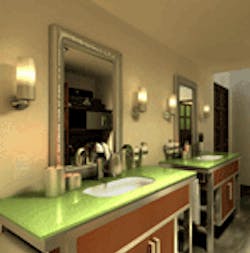Hotel Andaluz is sustainable, maintains historic charm
ALBUQUERQUE, N.M. — Following a $30 million renovation, the historic La Posada de Albuquerque Hotel here, now known as Hotel Andaluz, truly is a sustainable hotel — it is utilizing water- and energy-efficient systems and products, and pursuing U.S. Green Building Council LEED Gold certification. When the hotel receives this certification, it may be a first for a hotel on the National Register of Historic Places.
Located in the desert Southwest, Albuquerque faces water shortages and potential water restrictions throughout the year. Because of water use concerns, it was imperative for the hotel to be renovated with state-of-the-art technologies and products that conserve water, and naturally, it was a must for high-efficiency toilets to be installed in the hotel’s guest rooms.
Goodman Realty Group, a full service, national real estate firm, with experience in construction, management and leasing of a variety of properties, including the Hotel Andaluz, chose Caroma to furnish 118 HETs for hotel guest rooms because of water savings and toilet design.
The Sydney Smart 270 Elongated and Caravelle 270 Easy Height Elongated HETs replaced 3.0-gpf toilets. Both Caroma toilets (and all floor-mount toilets by Caroma) are WaterSense labeled. The WaterSense program, sponsored by the U.S. Environmental Protection Agency, mandates that toilets use 20% less water than the current federal standard.
“When the hotel was bought by Goodman Realty Group in 2005, there were 3.0-gpf toilets installed,” explained Darin Sand, LEED AP, Goodman Realty Group. “We expect to save at least 45% of indoor water usage by using Caroma toilets. At a minimum, we’d expect more than 100,000 gallons of water saved each year assuming just 50% occupancy and four flushes per room per day. Additionally, using these toilets is a key component in helping us receive three points towards LEED certification.”
The Sydney Smart range is a dual-flush toilet, featuring two buttons. The full flush button uses 1.28-gpf for solid waste, and the half flush button uses 0.8-gpf for liquid and paper waste. Assuming a 1:4 full/half flush ratio, it averages 0.90-gpf. The Caravelle HETs average 0.96-gpf, using 1.6 gallons for a full flush and 0.8 gallons for a half flush.
According to Sand, one of the main reasons Caroma toilets were chosen was because of the adjustable rough-in.
“This hotel was originally opened in 1939, and during that time, rough-ins were usually 10-in.,” explained Sand. “However, when we were remodeling the bathrooms, we discovered that the rough-ins were 10-in., 11-in., 12-in., or somewhere in-between. With the offset connector supplied with the Caroma toilets we chose, we could easily handle any of these variations.”
Since the hotel has reopened, there have been no clogs or blockages.
“Compared to other toilets that have a small trapway, the Caroma HETs have basically eliminated the need for maintenance to fix toilet issues,” said Sand. “That not only helps keep the maintenance costs down, but it also eliminated the possibility that guests will be frustrated or embarrassed by toilet issues.”
Besides utilizing high-efficiency toilets to conserve water, a 7, 500-gal. rainwater capture system is being installed to reduce storm water runoff and irrigate outdoor and indoor landscaping at the hotel. Rainwater will be collected from the 10th and 11th story roofs —a total of 6,200-sq.ft. of roof space — and stored in three 2,500-gal. cisterns.
According to Sand, the three cisterns will be put inside the adjacent parking structure, and stored water will be used to irrigate the tree lined street and the plants in the hotel. It is estimated that stormwater runoff will be reduced by more than 25%.
At this time, according to Sand, the renovated hotel is using approximately 76% less water than before it was renovated, and the rainwater capture tank has not even been installed yet.
Solar and more
Another sustainable feature of the hotel is a solar heated hot water system with 73 solar panels. The system provides 60% of the heating required for domestic hot water for the hotel’s kitchens, restaurant, laundry and guest rooms.
“This is doing an amazing job,” said Sand. “The solar system preheats water before it travels to the boiler. As a result, the boiler doesn’t have to work as hard to maintain the proper temperature.”
The renovated hotel also has a central HVAC plant with a cooling tower. Components of the HVAC system include small boilers, which are 87% efficient, and two Trane chillers.
“Part of the reason why we picked this [small sized boilers] is because it would fit down the access door in the sidewalk that goes into the basement,” explained Sand. “The basement was not originally designed to house large equipment, so we did not have a lot of space to work with.”
Other environmentally-friendly features of the hotel include an integrated building energy management system, the Trane Tracer Summit, to control the heating, cooling and lighting when the room is unoccupied and interior finishes incorporating natural, recycled and low volatile organic compound (VOC) products.
“This renovation illustrates that green state-of-the-art technology can be blended successfully in historic renovations while maintaining the build’s historic character,” said Sand.
